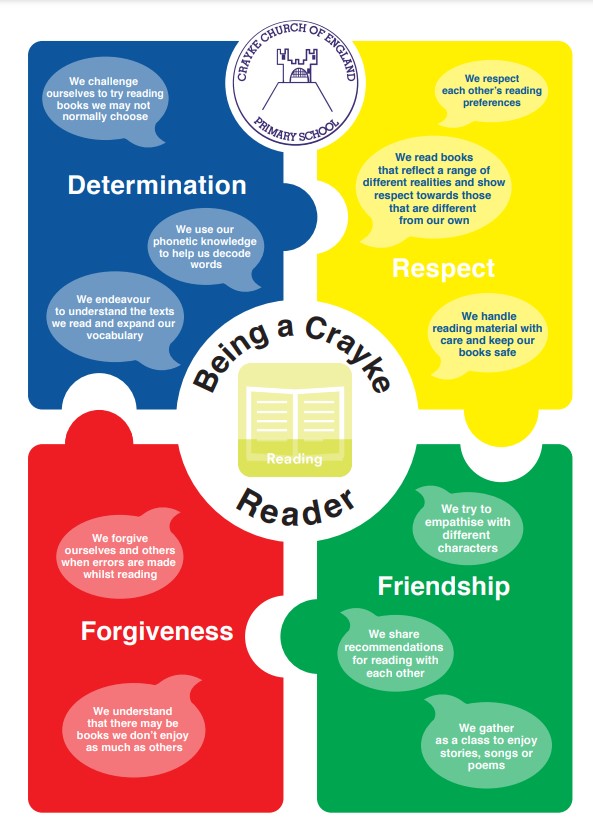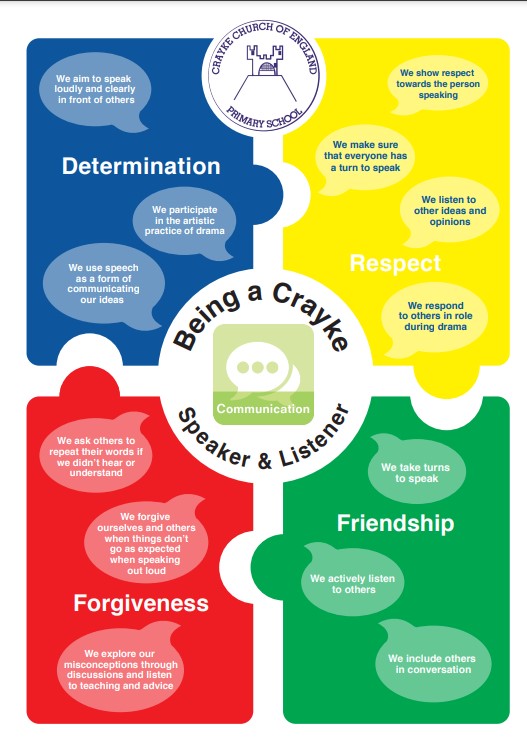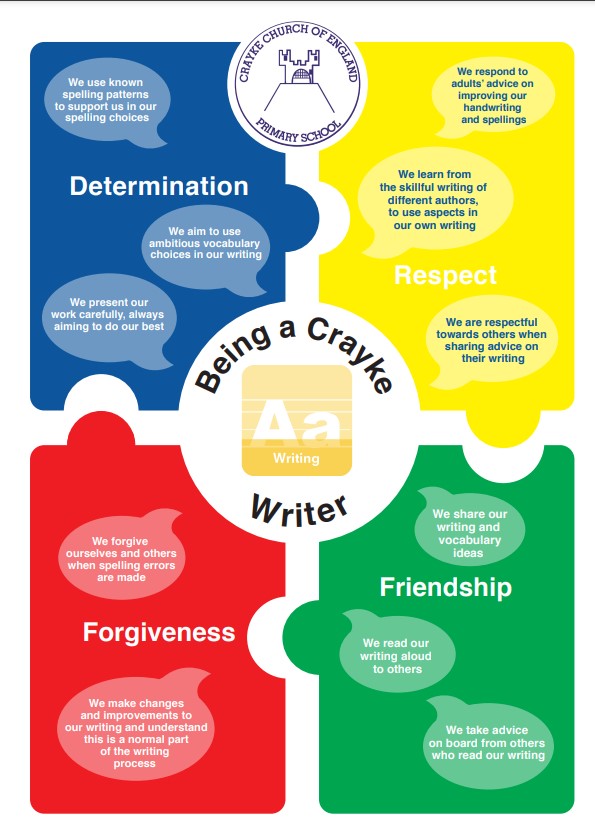
This page provides details about what English looks like at Crayke Primary. It includes our Intent Statement, our coverage and progression document and our “jigsaw” explaining how teaching and learning in English links to our four core values of Friendship, Forgiveness, Respect and Determination.
The English Subject Leader is: Mrs Rayner.
Details relating to Coverage and Progression in this subject can be found here:
Speaking and Listening:
Coverage and Progression in Speaking and Listening EYFS
Coverage and Progression in Speaking and Listening Y1 – Y6
Reading:
Coverage and Progression in Reading Y1 – Y6
Writing:
Coverage and Progression in Writing EYFS – Y6
Handwriting:
Coverage and Progression in Handwriting EYFS – Y6
Spelling:
Coverage and Progression in Spelling Y2 – Y6
English NC Programme of Study

Ensuring access to a rich, broad and balanced curriculum, based upon and framed by our school values of Respect, Determination, Friendship and Forgiveness, is at the heart of Crayke’s provision…
Rationale:
The fundamental aim of Crayke Church of England Primary School is to provide opportunities for children to develop as independent, confident, successful learners with high aspirations; creating citizens of the future who know how to make a positive contribution to their community and the wider society. This aligns with our school vision which strives to enable children to “Follow your pathway and grow together with confidence.”
This document has been divided into the following areas of English:
- Reading and phonics
- Writing
- Speaking and listening
Reading and Phonics
Reading and Phonics Intent:
Being a Crayke reader, supported by the 2014 National Curriculum for English and the ‘Little Wandle’ systematic and synthetic phonics programme aims to ensure that all children:
- Are enthusiastic and motivated readers with a love of literature
- Can tackle unfamiliar words as they read
- Are fluent and expressive readers
- Have the skills and knowledge to understand what they read
- Read widely across the curriculum for meaning and pleasure
- Use what they read to inspire them in their writing
- Gain a rich and varied vocabulary
Reading and Phonics Implementation:
We teach phonics and early reading through Little Wandle Letters and Sounds Revised, which is a systematic and synthetic phonics programme. We start teaching phonics in Reception and follow the Little Wandle Letters and Sounds Revised progression, which ensures children build on their growing knowledge of the alphabetic code, mastering phonics to read and spell as they move through school.
Phonics lessons build up quickly to 30 minutes a day in reception and Year 1. Any child who needs additional practice has daily Keep-up support, taught by a fully trained adult. Keep-up lessons match the structure of class teaching, and use the same procedures, resources and mantras, but in smaller steps with more repetition, so that every child secures their learning.
Teaching reading in Reception and Year 1
- We teach children to read through reading practice sessions three times a week. These:
- are taught by a fully trained adult to small groups of approximately six children
- use books matched to the children’s secure phonic knowledge using the Little Wandle Letters and Sounds Revised assessments and book matching grids on pages 11–20 of ‘Application of phonics to reading’
- are monitored by the class teacher, who rotates and works with each group on a regular basis.
- Each reading practice session has a clear focus, so that the demands of the session do not overload the children’s working memory. The reading practice sessions have been designed to focus on three key reading skills:
- decoding
- prosody: teaching children to read with understanding and expression
- comprehension: teaching children to understand the text.
- In Year 2 and 3, we continue to teach reading in this way for any children who still need to practise reading with decodable books.
From Year 2, reading comprehension skills are taught explicitly using a range of resources including ‘Comprehension Ninja.’ Children have access to a range of high-quality texts within the classroom to read for pleasure and books are displayed prominently to interest the children. We have close links with our local library and also buy into a ‘Reading Rocks’ box for each class every half term, which provides at least two recently published high-quality texts. Reading ambassadors (two children from each year group from Year 1 to Year 6,) represent and encourage a love of reading across the school. We create opportunities across the school for children to enjoy a range of high-quality fiction, non-fiction and poetry. Every class has story time each day, for the pleasure of listening to a high-quality story.
Home reading
For children being taught phonics lessons, the decodable reading practice book is taken home to ensure success is shared with the family once the three reading practice sessions have taken place in school. Reading for pleasure books also go home for parents to share and read to children in reception, Year 1 and 2.
We use the Little Wandle Letters and Sounds Revised parents’ resources to engage our families and share information about phonics, the benefits of sharing books, how children learn to blend and other aspects of our provision, both online and through workshops.
Once children can fully decode, have passed their phonics screening check in Year 1 and are becoming increasingly fluent, they move onto the main school reading scheme. We use ‘Collins Big Cat,’ providing a link between the phonics reading books and reading beyond those texts. These books also expose children to a wide range of styles and genres of book, leading onto children becoming a ‘free reader’ further on in Key Stage Two.
Our dedicated ‘Reading Newsletter’ engages parents, carers and older children with the latest events and updates with reading at Crayke. It also introduces them to a range of different authors, often with authors and illustrators contributing to our reading newsletter, too.
Reading and Phonics impact:
Impact will be measured by assessing against the National Curriculum Age-Related Expectations statements through ‘Insight pupil tracking’ at termly intervals as:
Below, Just Below, On Track, Greater Depth
A standardised score from termly NFER tests will help inform the termly teacher judgements. The ‘Little Wandle’ assessment tool will be used for all children in reception and Year 1 each half term, whilst any children receiving keep-up additional phonics teaching will be assessed every three weeks using Little Wandle assessment tool. Pupils will sit statutory assessments in reading at the end of KS1 and KS2. Children in Year 1 will sit the phonics screening check. Children in reception are assessed against the ‘Early Learning Goals.’
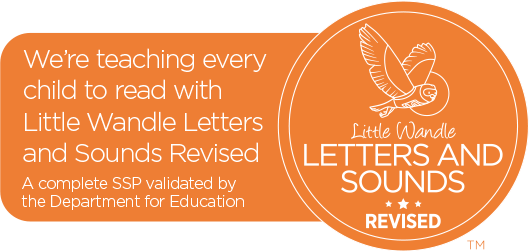
http://www.littlewandlelettersandsounds.org.uk
Writing
Writing Intent:
Being a Crayke writer, supported by the 2014 National Curriculum for English, Jane Considine ‘Write Stuff’ approach and the ‘Penpals’ handwriting scheme, aims to ensure that all children:
- Are enthusiastic and motivated writers
- Can explore and draw upon a range of taught spelling patterns and exceptions
- Are fluent writers who take pride in the presentation of their work
- Make ambitious vocabulary choices and are inquisitive about the meanings of words
- Understand and use grammatical features and punctuation to good effect in their writing
- Can apply their range of writing skills in other curriculum areas
- Consider the intended audience and purpose of their writing
Writing Implementation:
We teach writing composition, grammar and punctuation through a combination of ‘Jane Considine’ writing units once a term and teacher-planned lessons, following the ‘I do, we do, you do’ lesson format. The Jane Considine approach uses the ‘Writing Rainbow,’ which is a clear and systematic approach with visual symbols to represent different aspects of writing.
We start teaching using the Jane Considine units in Reception through discussions of the ‘FANTASTICs’ where children are encouraged to speak in full sentences. This is built upon with the introduction of writing units in Year 1 so that children are familiar with the format and can make ambitious vocabulary choices as they move throughout the school.
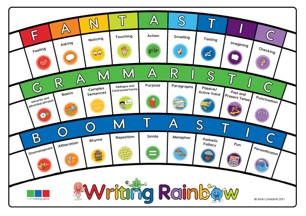
Children then also get to apply their learning in a different lesson format, where the teacher still models but the emphasis is on the children becoming increasingly independent writers. Teachers carefully decide whether to teach a particular aspect of grammar and punctuation explicitly, or as part of a writing lesson in context.
Spellings are taught in a weekly ‘Word Study’ session from Year 2 onwards. The ‘Word Power League’ (from Kelly Ashley Consultancy,) are used as lenses to explore different aspects of words to not only improve children’s knowledge of spelling patterns, but to also widen their understanding of different vocabulary. A two-year rolling programme is used for years 3&4, and 5&6 in order to teach spelling patterns in depth. Children in reception and Year 1 explore the spellings of words through their ‘Little Wandle Letters and Sounds Revised’ systematic synthetic phonics programme.
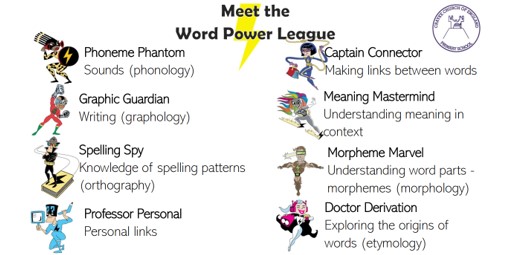
Spelling Coverage and Progression documents from Year 2 – 6 can be found here: Crayke Spelling and Progression
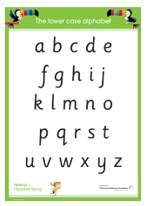 Handwriting is taught from reception, using ‘Penpals’ handwriting workbooks to support children in developing their fine-motor skills. Weekly handwriting ‘Penpals’ lessons take place up until the end of Year 4, with children in Year 5 and 6 applying what they have learnt and moving towards developing their own style. Any children who require support continue to receive handwriting instruction.
Handwriting is taught from reception, using ‘Penpals’ handwriting workbooks to support children in developing their fine-motor skills. Weekly handwriting ‘Penpals’ lessons take place up until the end of Year 4, with children in Year 5 and 6 applying what they have learnt and moving towards developing their own style. Any children who require support continue to receive handwriting instruction.
Writing Impact:
Impact will be measured by assessing against the National Curriculum Age-Related Expectations statements through ‘Insight pupil tracking’ at termly intervals as:
Below, Just Below, On Track, Greater Depth
A termly whole school writing stimulus for children to write independently, will help inform the termly teacher judgements along with children’s written work from across the term and curriculum. Children in reception are assessed against the ‘Early Learning Goals.’ The independent writing from across the school is collected and used to look at each child’s writing progress over time.
